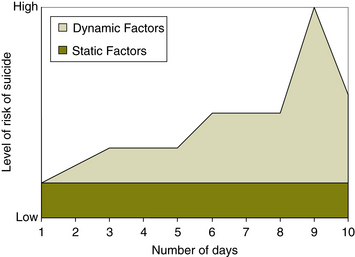Chapter 3 Risk factors and risk equations
Risk factors1
Risk factors can be divided into two main categories:
1. static factors (also referred to as enduring, stable or historic factors)
2. dynamic factors (also referred to as current or variable factors).
A comprehensive analysis of static risk factors can help ensure that clinicians take account of historical material and consider pre-existing vulnerabilities for (violence) risk when planning long-term treatment strategies.2
Some examples of static factors include:
• For violence: previous episodes of violence, conduct disorder and alcohol and drug history.
• For suicide: previous attempts, family history of suicide, history of mental illness.
Lists of risk factors for violence and suicide can be found in Chapter 9 (Tables 9.1 and 9.2, pp 80, 84).
The static factors set the context in which a clinician works.3 Empirically it makes sense that the closer the patient is to these factors in time, the greater the influence they will have. However there is currently no literature available to support this. An extreme example would be of a man who was repeatedly violent in his youth but is now presenting at the age of 75. The weighting given to these factors is likely to be less than had he presented at the age of 25.
Dynamic risk factors are those factors which are more likely to change:
• as a result of alterations in the patient’s mental state such as a lowering of mood (internal) and/or
• changes in the patient’s external environment (situational) such as the dissolution of a relationship or loss of job.
Dynamic factors capture the fluctuating nature of risk. Dynamic factors may change in both duration and intensity. A single event may cause changes to a number of dynamic risk factors creating a change to the overall risk. Assessing the dynamic factors is essential for considering the particular conditions, patterns and circumstances that place individuals at special risk. Hanson and Harris (2000)4 distinguished between stable and acute dynamic factors. Stable dynamic factors (e.g. traits of impulsivity or hostility) are unlikely to change over short periods of time, but can change gradually. In contrast, acute dynamic factors (e.g. drug use and mental state) can change daily or even hourly.
It is not sufficient to consider risk factors in isolation and manage them individually. Risk factors can affect each other in various ways. For example, one risk factor may moderate the effect of another or a second risk factor may only become relevant if the first risk factor is present. There are many possible permutations which will need to be formulated by clinicians for each patient. Whenever there are more than two causal risk factors these issues must be considered.5 (A causal risk
BOX 3.1 THE NATURE OF RISK
• Risk in a mental health setting is never static.
• The likelihood of the risk behaviour occurring is often linked to the severity of the illness.
• The nature of a patient’s risk doesn’t usually change; it is the likelihood and context which changes.
• The likelihood of the risk changes most with changes of the dynamic factors.
• Given the fluctuation of dynamic risk factors in patients, measures of the level of risk may have little value other than stating what it was on that particular day.
• If there is a heavy weighting of static risk factors, this is worth highlighting as the tipping point into the risk behaviour may be reached quickly.
factor is one that can be changed by manipulation and when changed can be shown to alter the risk.)
In some persons with mental or personality disorder and a history of violence or self-harm, a highly specific, ‘signature’ set of patterns or signs may be identified (e.g. a preoccupation with certain people, or a change to a behaviour pattern), as a ‘calling card’ for their mental illness and the potential risk for violence to self or others.6
These personal signature risk signs and patterns of behaviour can be useful concepts for clinicians to consider when assessing patients. The concept of ‘signature risk signs’ has been incorporated into the thinking behind ‘START’, an assessment tool currently being evaluated.7 Along similar lines, the concept of ‘critical risk factors’ is also worth considering. These are 2–3 risk factors which will be of great importance for specific individuals and can be highlighted in management plans as flags for rapid intervention.
Looked at diagrammatically, risk factors can be presented as shown in Figure 3.1.8
When it comes to documenting the risk, this diagram can be referred to. The risk documentation framework used in the book is to a large degree based on this model.
Example 1 — violence risk factors
The synthesis of the static and dynamic risk factors combines to give the current ‘risk state’.9, 10 The risk state is a term used in some literature to describe the likelihood of the risk occurring at a given time.
The graphs in Figures 3.2 and 3.3 help describe the idea of risk being a synthesis of static and dynamic factors. The second graph also shows how the likelihood of the risk occurring can change quickly.









